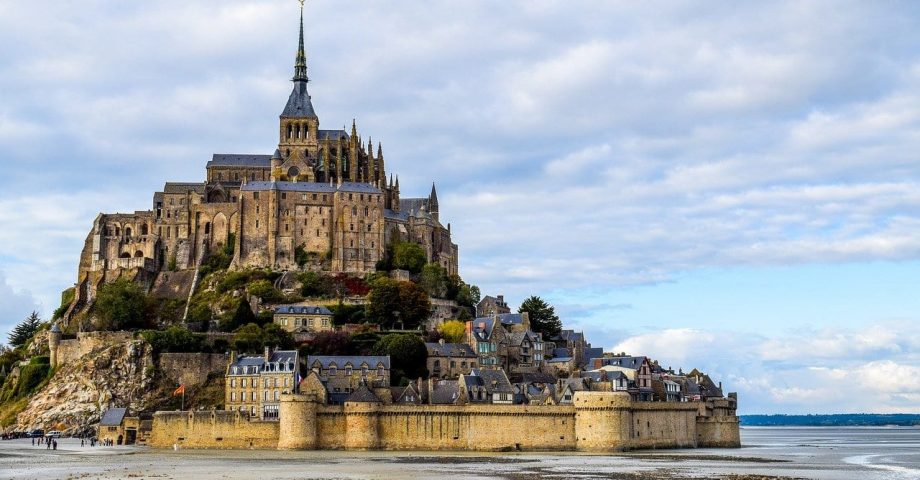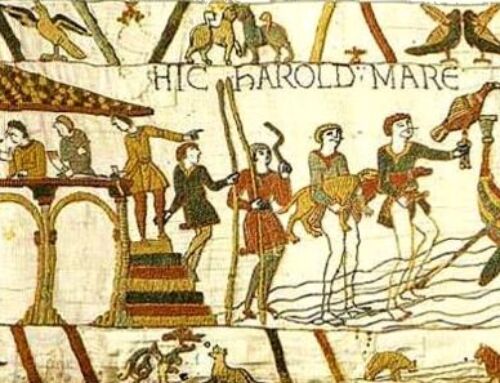“Mont Saint-Michel has broken the English siege!” cried the messenger as he galloped into the little town of Domrémy at the far eastern edge of France. It was the year 1424 AD, and a twelve-year-old girl of that town named Jehanne received the news with open enthusiasm.
“There is hope for the kingdom of France yet!” exclaimed the girl with renewed conviction about the fate of her native land.
That announcement might have been the only bright spot of news the French loyalists had received during the long and painful saga of the Hundred Years War (14th-15th centuries). France had not won a major battle against the English for over seventy years – until that point.
Hardly one year later, that same girl from Domrémy – Joan of Arc – would be visited by Michael the Archangel himself and would be given the mission of breaking another English siege and bringing France’s hope to fulfillment.
Resistance and Inspiration
Mont Saint-Michel, the fortress-island sitting in the English Channel just off the coast of Normandy, was named after the great Archangel Michael and was well-known to all the French. When the messenger brought the good news, it remained unconquered in the seven hundred years since it had been established.
In fact, it was a symbol of French resistance against the English. Its hold-out against the siege was a bolt of lightning from heaven for the whole nation. We might liken its inspiration to the cry of “Remember the Alamo!” – a sort of a rallying point of patriotism – though, unlike the Alamo, Mont Saint-Michel was not taken.
The seventeen acre fortress-island is now 1300 years old and to this day it has never been conquered (although we must admit that it’s more of a tourist site these days than a bone of contention between warring nations.) But it is still a source of enormous inspiration for those who consider its place in history and its spiritual value.
The Unconquered Fortress
That’s not to say that Mont Saint-Michel is without its scars. It has many. After Joan of Arc turned the tide of battle, the English found themselves being pushed out of France and tried again to occupy the island in 1433-34. They failed a second time. When they withdrew, they left two iron cannons behind, which you can see today displayed on the island.
During the French Revolution (1789-94) Mont Saint-Michel was looted and vandalized, and then – horror of horrors – Napoleon used it as a prison. It was reclaimed in 1862 and, after that, the famous French writer, Victor Hugo, led a national effort to restore the island to its former glory. (The author of The Count of Monte Cristo knew something about island prisons.)
During the Second World War, when France was occupied, the Germans used it as an observation post over the English Channel, but it was not militarized according to a German-French agreement.
It was from the beaches of Normandy, just north of Mont Saint-Michel, that the Allies launched their D-Day invasion in 1944 and began the re-conquest of Europe – as if under the aegis of St. Michael. When the Allies took control of France, the Germans abandoned the island without firing a shot.
Because of its history and position, Mont Saint-Michel is a jewel of both culture and grace standing in the Channel between two nations. In a way, it also stands metaphorically between heaven and earth. As you can see from the picture, it is sort of its own kind of sacred window, pointing the viewer’s eye in one direction – heavenward.

An Edifice of Spirit
In so many times and places throughout Catholic history, the Church has taken a natural wonder and built it into a spiritual edifice. That is definitely the case with Mont Saint-Michel, which is a natural outcropping of rock sitting in the middle of a wide plain of mud and quicksand. It’s known technically as a tidal island.
That highlights one natural reason for the island’s unconquerability: its location in the English Channel where tides reach their highest levels. Every day the tides swell up to fifty feet and rush in like a herd of stallions. Nautical technology today has little trouble managing tidal shifts of that magnitude, but the more primitive vessels and military tactics of ages past found them unmanageable.
How, exactly, would a Medieval army set up siege works in quicksand with a fifty foot tide coming and going on a daily basis?
The island also has the spiritual protection of its great patron, of course, which cannot be discounted throughout its spectacular history. A medieval legend says that the sky above Mont Saint-Michel was the exact place where St. Michael threw the devil out of heaven, but if you’re like me, you’ll probably find that a little hard to believe!
Somewhat more credible, however, is the story of the island’s founding. An early Medieval bishop, St. Aubert (d. 720 AD), had a vision of the great Archangel who told him to build a church on the island. Aubert was not sure initially whether the vision was from God or the devil, but Michael appeared to him twice more and “convinced” Aubert of his authenticity by touching him on the forehead and telling him to get to work. Angels don’t fool around.
The Church has always recognized this island as a spiritual oasis. Since early medieval times, Mont Saint-Michel has been a place of Christian pilgrimage, second only to Santiago de Compostela in northern Spain, where the faithful journeyed to offer their prayers to heaven and to ask the great angel’s intercession. Even today, it receives over three million visitors a year.
Incremental Growth
The history of the island is one of constant, incremental growth – upward, as it were – mirroring in some way the unfolding of doctrine and growth of the Church itself.
Upon the foundation of ground-level retaining walls and fortifications, numerous other levels, structures, and battlements were carved into the rock and added over time (monasteries, chapels, houses, shops, a cemetery, and even three hotels), each level reaching higher than the next, each structure supplying its own period style of architecture.
A Gothic Benedictine abbey church crowns the very pinnacle of the rock; its spire displays a golden statue of a sword-wielding St. Michael. The Benedictines were driven out at the time of the French Revolution, and today a dozen monks and nuns of the Monastic Fraternities of Jerusalem live there and pray for the salvation of the world. The population of the entire island is only about thirty, not counting tourists staying in the Mont’s hotels!
There are no escalators up the mountain, so you have to walk the 900 or so steps to see the monastic church at the top. I’ve climbed them and can personally attest that every step is worth the effort, not to mention the spectacular view of the Normandy coast from the heights of the island.
Water, Land, Sky – and Drones
Someone once said that Mont Saint-Michel has its feet in the water and its head in the clouds, and you only have to visit it once to know that the experience of solid rock and holiness pervades the entire island. It remains an enormously significant spiritual witness for the world beyond its obvious cultural heritage for the French people.
Looking at the island from a distance, one gets the impression of a grand sculpture of both natural and human architecture, with all of its elements fused together so perfectly over many ages that it seems like a kind of spiritual diamond formed in the fires of heaven, crystalized through human history, and set into its crown by the Prince of the Heavenly Host himself.
If you have a few moments today, make sure you take a flyover tour of the magnificent island through the eyes of a drone. The first video link (2:41 mins.) shows the tides flowing in and out, sort of a “Day in the Life of Mont Saint-Michel” view of things; this one ends with a fantastic close-up view of the statue of St. Michael at the top of the spire – wow! The second (3:23 mins.) focuses on the architecture.
(And don’t ask me how they got permission to fly a drone into the church, but there you have it!)




Leave A Comment